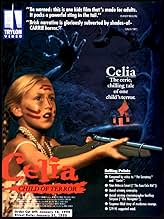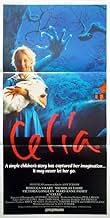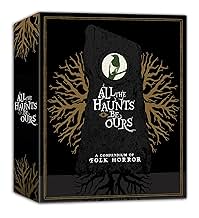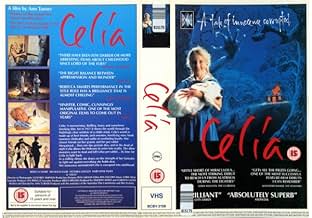PUNTUACIÓN EN IMDb
6,8/10
1,6 mil
TU PUNTUACIÓN
Una joven imaginativa y algo perturbada fantasea con criaturas malvadas y otras rarezas para enmascarar sus inseguridades mientras crece en la Australia rural.Una joven imaginativa y algo perturbada fantasea con criaturas malvadas y otras rarezas para enmascarar sus inseguridades mientras crece en la Australia rural.Una joven imaginativa y algo perturbada fantasea con criaturas malvadas y otras rarezas para enmascarar sus inseguridades mientras crece en la Australia rural.
- Premios
- 2 premios y 2 nominaciones en total
Argumento
¿Sabías que...?
- CuriosidadesThe fairy tale from which extracts were recited in the film was The Hobyahs by James H. Fassett and Robert D. San Souci.
- PifiasThe burn mark on Celia's rabbit is missing at the fishing docks.
- ConexionesFeatured in Film Review and Interview with Ann Turner from the 'Sunday' show (1989)
Reseña destacada
Celia is a little girl with an active imagination who is watched over by the spirit of her grandmother, who raised her, up until the point where she found her dead.
She doesn't have many other friends, that is, until a new family arrives next door.
She becomes very close with them...but her father refuses to let her play with their kids, because of their communist associations (though, he keeps hitting on their married mother).
Her and her friends are locked in a heated battle with a rival group of children.
With the rivalry becoming increasingly violent as the film progresses.
More than anything in the world...she wants a white rabbit with a black ear, whom she loves dearly.
But her father only agrees to get it for her if she promises never to play with the neighbour kids again.
Though, when she refuses to abide by this promise...he gets their father fired (by outing him as a communist sympathizer).
The association between communists and rabbits, here, being metaphorical.
As the plot of the film revolves around rabbits being demonized as an invasive species in Australia.
With the film being laden with newsreels about them being a plague.
But it's not the communists and rabbits that come off as the villains.
Quite the contrary.
So, when the state starts to call for banning the keeping of rabbits as pets...Celia can see the good in her friends, and their family, like she sees the good in her beloved pet.
Thus, much like little Celia...the film has a subversive quality to it.
Which is why, when she is on the brink of losing both her friends...and her rabbit...she tries turning to black magic to try and fix all her problems.
Though...she soon learns that she must fight for, not only, the things she loves...but also what's right...by any means necessary.
Ultimately leading to the film's dark conclusion.
The whole thing is a fantastical, coming of age tale that is both dark and political; and messes with your emotions.
Running the gamut from making you angry...to making you cry.
I'm not sure there has ever been a film made for children that has been so powerful, in so many ways.
So in short: it's an absolute classic.
And must see for cinephiles, as it has qualities that seem to have influenced other films...most notably Fade To Black.
8.5 out of 10.
She doesn't have many other friends, that is, until a new family arrives next door.
She becomes very close with them...but her father refuses to let her play with their kids, because of their communist associations (though, he keeps hitting on their married mother).
Her and her friends are locked in a heated battle with a rival group of children.
With the rivalry becoming increasingly violent as the film progresses.
More than anything in the world...she wants a white rabbit with a black ear, whom she loves dearly.
But her father only agrees to get it for her if she promises never to play with the neighbour kids again.
Though, when she refuses to abide by this promise...he gets their father fired (by outing him as a communist sympathizer).
The association between communists and rabbits, here, being metaphorical.
As the plot of the film revolves around rabbits being demonized as an invasive species in Australia.
With the film being laden with newsreels about them being a plague.
But it's not the communists and rabbits that come off as the villains.
Quite the contrary.
So, when the state starts to call for banning the keeping of rabbits as pets...Celia can see the good in her friends, and their family, like she sees the good in her beloved pet.
Thus, much like little Celia...the film has a subversive quality to it.
Which is why, when she is on the brink of losing both her friends...and her rabbit...she tries turning to black magic to try and fix all her problems.
Though...she soon learns that she must fight for, not only, the things she loves...but also what's right...by any means necessary.
Ultimately leading to the film's dark conclusion.
The whole thing is a fantastical, coming of age tale that is both dark and political; and messes with your emotions.
Running the gamut from making you angry...to making you cry.
I'm not sure there has ever been a film made for children that has been so powerful, in so many ways.
So in short: it's an absolute classic.
And must see for cinephiles, as it has qualities that seem to have influenced other films...most notably Fade To Black.
8.5 out of 10.
- meddlecore
- 19 oct 2024
- Enlace permanente
Selecciones populares
Inicia sesión para calificar y añadir a tu lista para recibir recomendaciones personalizadas
- How long is Celia?Con tecnología de Alexa
Detalles
- Fecha de lanzamiento
- País de origen
- Sitios oficiales
- Idioma
- Títulos en diferentes países
- Celia: Child of Terror
- Localizaciones del rodaje
- Empresa productora
- Ver más compañías en los créditos en IMDbPro
- Duración1 hora 42 minutos
- Mezcla de sonido
- Relación de aspecto
- 1.85 : 1
Contribuir a esta página
Sugerir un cambio o añadir el contenido que falta

Principal laguna de datos
By what name was Celia (1989) officially released in India in English?
Responde























